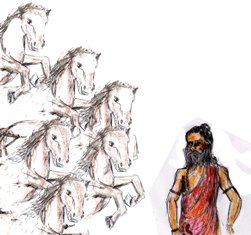Story & Trivia
In mythological times, the Kosi was called Kaushiki.
Brahma had a Kusha and Gadhi was his grandson who had a daughter Satyavathi. The venerated sage Richika asked to marry Satyavathi. Gadhi was not agreeable to the young and beautiful Satyavathi marrying the much older Richika. So he asked Richika to bring a dowry of one thousand white horses each with one black ear, assuming it would be impossible for the old Brahmin to do it.
The venerated sage Richika asked to marry Satyavathi. Gadhi was not agreeable to the young and beautiful Satyavathi marrying the much older Richika. So he asked Richika to bring a dowry of one thousand white horses each with one black ear, assuming it would be impossible for the old Brahmin to do it.
But, Richika immediately went to Varuna for help and got his thousand horses, which he promptly presented to Gadhi and married Satyavathi. There came a point when both she and her mother wanted sons. Satyavathi wanted a learned son and her mother wanted a son with warrior traits. Richika being a powerful sage prepared two bowls of magical porridge, one for Satyavathi and one for her mother.
The mother assumed the sage would have prepared a more powerful porridge for his wife Satyavathi. She persuaded her daughter to exchange the bowls. When Richika heard this, he was furious, for now Satyavathi would bear a warrior. When she begged him to set it right, he said her grandson would bear the warrior traits, not her son.
And so it happened that Satyavathi bore Jamadagni, a scholarly sage, whose son was the ferocious Parashurama. Her mother bore Vishwamitra, who was initially a powerful king but then went on to become a powerful sage. As Vishwamitra was born in the dynasty of Kusha, Vishwamitra was also called Kaushika and his sister was Kaushiki.
Over time Richika died and went to heaven and Satyavathi too followed him there. This Satyavathi who was also called Kaushiki is the river which descended on Earth as the river Kaushiki. The name over time morphed to Kosika and then Kosi. Even today there are many old folksongs in which Kosika is used.
Saptakosi
Indravati, Sun Kosi , Tama Kosi, Likhu Kosi, Dudh Kosi, Arun Kosi, and Tamar Kosi are the seven streams which form Saptakosi. Eventually it’s just called the Kosi.
Ten-armed Monster
The Kosi carries down huge amounts of water, but the enormous silt she carries is the problem. As the Kosi waters subside, the silt settles, raising the river bed. Over time this forces the river to cut new channels to flow when she hits the plains flowing down from the Himalayas. Thus Hindu mythology equates the Kosi with a ten-armed monster for all the channels through which it drains the plains of Bihar
Yet another legend
In times of legends, a demon asked the beautiful Kosi to be his bride. She agreed provided he could contain her within the Himalayas by morning. The demon slogged through the night and to Kosi it appeared like he would succeed. Worried, she took Shiva her father’s help. He disguised himself as a rooster and crowed a little just before dawn. The demon thought he had lost and went away, leaving the Kosi free to flow where her heart took her.
Getting a river to leave
Even today, women pray for her to come for she brings a wealth of silt from the Himalayan slopes, which is very good for their land. But, when the Kosi floods villages and the water levels do not drop in 2-3 days, the villagers offer turmeric. This is representative of marriage and it is said the river who enjoys being unmarried, then leaves in a great hurry!
Song of the Kosi
The folklore of the surrounding areas has given birth to numerous folksongs which talk of the Kosi sometimes as a treacherous maiden who gets a boatman to take his boat out into the river in spite of his knowing that his oar is broken. As the maiden she even promises to get him an oar of gold!
There is also a folksong of lamentation by a mother who has lost seven sons and is afraid Mother Kosi will take the eighth.
In some songs people who have died lament about the loss of their life and how they have become a sacrifice to the river. Other songs speak of the sacrifices they will make to Mother Kosi to placate her floods – offerings of a sweet sandesh, paan, laddu etc.
Songs in which Kosi adorns herself are also sung. From myth to folklore, Kosi is an intrinsic part of the lives of people on her banks.
Trivia
1. The Kosi River is called the Koshi River in Nepal.
2. It is actually a prominent tributary of the Ganga.
3. Its source is in the Himalayas and it flows through Nepal and northern India, extending into many tributaries of its own along the way.
4. The Kosi is known as the “sorrow of Bihar“ because of its unpredictable and severe flooding.
5. Over the last three centuries, the rivers course has gone 120 km to the west.
6. A great deal of money is being spent to repair the damage of the treacherous floods this river has.
7. The Kosi is good for river rafting as well as fishing.
8. The river provides groundwater and irrigation to an area that doesn’t have another water source.
9. The Kosi river and its many extensions and tributarites form the shape of an alluvial cone, or a fan.
/articles/kosi-river